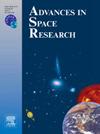Kinetic instabilities constraining proton temperature anisotropy in corotating interaction regions at 1 AU
IF 2.8
3区 地球科学
Q2 ASTRONOMY & ASTROPHYSICS
引用次数: 0
Abstract
Corotating Interaction Regions (CIRs), formed by the interaction between slow and fast solar wind streams, provide an ideal environment for studying plasma waves and instabilities. In this study, we analyze 290 CIR events using Wind spacecraft data at 1 AU during Solar Cycle 24 (2008–2019) to explore the relationship between proton temperature anisotropy and kinetic instabilities. Our results show that the Mirror Mode (MM) and Oblique Firehose (OFH) instabilities primarily regulate temperature anisotropy within CIRs for and respectively, even at . Although Proton Cyclotron Instability (PCI) is theoretically expected to operate at low , our observations and linear instability analysis suggest that for a growth rate of PCI does not significantly constrain or limit the anisotropy in CIRs, potentially due to inefficient energy extraction or the stabilizing effects of minor ions. However, the present study does not account for the effects of collision age and the presence of heavy ions, which may also influence anisotropy constraints in CIRs. Moreover, for , the anisotropy is constrained by a combination of MM, PCI, and firehose instabilities. These findings highlight that the mechanisms constraining temperature anisotropy in CIRs are consistent with those in the ambient solar wind and interplanetary coronal mass ejection’s sheath, underscoring the robustness of these regulatory processes across different heliospheric environments.
约束质子温度各向异性在1au旋转相互作用区域的动力学不稳定性
旋转相互作用区(CIRs)是由慢速和快速太阳风流相互作用形成的,为研究等离子体波和不稳定性提供了理想的环境。在这项研究中,我们利用Wind航天器在太阳周期24(2008-2019)期间1 AU的数据分析了290个CIR事件,以探索质子温度各向异性与动力学不稳定性之间的关系。我们的研究结果表明,镜像模式(MM)和斜消防胶管(OFH)不稳定性主要调节CIRs内的温度各向异性,分别为Tp⊥/Tp‖>;1和Tp⊥/Tp‖<;1,即使在βp‖< 2。虽然质子回旋不稳定性(PCI)理论上预计会在低βp‖下运行,但我们的观察和线性不稳定性分析表明,对于γ=10-3Ωp的增长率,PCI不会显著约束或限制CIRs的各向异性,这可能是由于低效的能量提取或次要离子的稳定作用。然而,目前的研究没有考虑碰撞年龄和重离子的存在的影响,这也可能影响CIRs的各向异性约束。此外,对于βp‖大于或等于2,各向异性受到MM、PCI和消防水带不稳定性组合的限制。这些发现强调了限制CIRs温度各向异性的机制与环境太阳风和行星际日冕物质抛射鞘中的机制一致,强调了这些调节过程在不同日球层环境中的稳健性。
本文章由计算机程序翻译,如有差异,请以英文原文为准。
求助全文
约1分钟内获得全文
求助全文
来源期刊

Advances in Space Research
地学天文-地球科学综合
CiteScore
5.20
自引率
11.50%
发文量
800
审稿时长
5.8 months
期刊介绍:
The COSPAR publication Advances in Space Research (ASR) is an open journal covering all areas of space research including: space studies of the Earth''s surface, meteorology, climate, the Earth-Moon system, planets and small bodies of the solar system, upper atmospheres, ionospheres and magnetospheres of the Earth and planets including reference atmospheres, space plasmas in the solar system, astrophysics from space, materials sciences in space, fundamental physics in space, space debris, space weather, Earth observations of space phenomena, etc.
NB: Please note that manuscripts related to life sciences as related to space are no more accepted for submission to Advances in Space Research. Such manuscripts should now be submitted to the new COSPAR Journal Life Sciences in Space Research (LSSR).
All submissions are reviewed by two scientists in the field. COSPAR is an interdisciplinary scientific organization concerned with the progress of space research on an international scale. Operating under the rules of ICSU, COSPAR ignores political considerations and considers all questions solely from the scientific viewpoint.
 求助内容:
求助内容: 应助结果提醒方式:
应助结果提醒方式:


